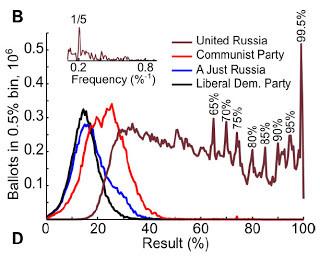Skupina raziskovalcev je pred nekaj dnevi v spletnem arhivu sicer pretežno fizikalnih člankov arXiv objavilo statistično analizo zadnjih predsedniških in parlamentarnih volitev v Rusiji: Statistical anomalies in 2011-2012 Russian elections revealed by 2D correlation analysis.
V njej pokažejo na kar nekaj nenavadnih anomalij v podatkih. Na voliščih, kjer je prišlo volit največ ljudi, jih je hkrati tudi zelo veliko volilo prav Putina in njegovo stranko. Prav tako sta Putin in njegova stranka pogosto dosegla okrogle rezultate izražene v odstotkih. Občutne razlike so tudi med rezultati na klasičnih voliščih s papirnatimi listki in skrinjicami ter novejšimi elektronskimi.
Here we perform a statistical analysis of the official data from recent Russian parliamentary and presidential elections (held on December 4th, 2011 and March 4th, 2012, respectively). A number of anomalies are identified that persistently skew the results in favour of the pro-government party, United Russia (UR), and its leader Vladimir Putin. The main irregularities are: (i) remarkably high correlation between turnout and voting results; (ii) a large number of polling stations where the UR/Putin results are given by a round number of percent; (iii) constituencies showing improbably low or (iv) anomalously high dispersion of results across polling stations; (v) substantial difference between results at paper-based and electronic polling stations. These anomalies, albeit less prominent in the presidential elections, hardly conform to the assumptions of fair and free voting. The approaches proposed here can be readily extended to quantify fingerprints of electoral fraud in any other problematic elections. (vir: Physics Buzz: Statistical Analysis Hints at Voter Fraud in Russia)








